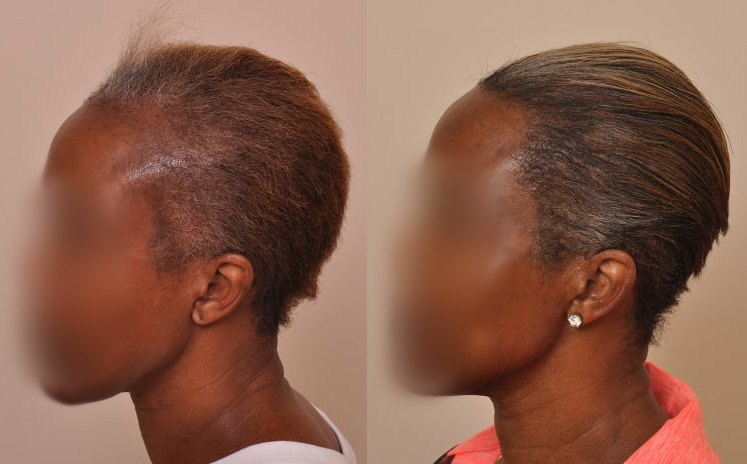Experiencing hair loss can be particularly challenging for women, affecting not just appearance but also self-confidence.
To better understand the non-surgical treatments available for women’s hair loss, we spoke with Dr. Ken Anderson, Medical Director and Chief of Surgery at Anderson Center for Hair.
He provided valuable insights into the key aspects of hair loss, from understanding the root causes to exploring the best available treatments.
In a rush? Jump to a section that sparks your interest below.
How Do Hair Loss, Shedding, and Breakage Differ?
“People often confuse hair loss with shedding and breakage, but these are distinct issues,” says Dr. Anderson.
Here are the key differences between hair loss, shedding, and breakage.
- Hair Loss: Known as alopecia, hair loss is a gradual or sudden decrease in hair growth. Women typically experience thinning across the scalp rather than localized bald spots, which are more common in men. Causes can range from genetic predisposition to hormonal imbalances or health conditions.
- Shedding: A normal part of the hair’s life cycle, shedding occurs when hair naturally falls out during the telogen phase of growth. Losing 50 to 100 hairs daily is considered typical, but factors like stress, illness, or hormonal shifts can cause an increase in shedding.
- Breakage: Unlike hair loss and shedding, breakage involves the hair shaft snapping off rather than hair falling from the root. Chemical treatments, heat styling, or improper handling of hair often lead to breakage, which can give the appearance of thinning but doesn’t affect the hair follicle.
How Can I Identify Whether I’m Experiencing Hair Loss, Shedding, or Breakage?
To determine which issue you’re facing, take a close look at your hair’s characteristics and patterns.
- Hair Loss: You might notice visible scalp thinning or wider parts. If you’re losing hair from the root, you may see a white bulb at the end of the strand.
- Shedding: Normal hair shedding is generally not alarming and involves entire strands falling out from the root. Stress or illness can cause this to increase temporarily, but it typically resolves on its own.
- Breakage: Breakage is often apparent when hair strands appear frayed or vary in length. This is a result of damage to the hair shaft, usually caused by external factors like harsh chemicals or heat.
Common Causes of Hair Loss in Women
Dr. Anderson points out that androgenetic alopecia is the leading cause of hair thinning in women. “This genetic condition leads to a gradual reduction in hair density, particularly at the top and sides of the scalp,” he explains.
Other factors contributing to hair loss include:
- Telogen effluvium, triggered by stress or diet changes.
- Alopecia areata, an autoimmune disorder causing patchy hair loss.
- Traction alopecia, due to tight hairstyles.
- Medications, certain medicines cause side effects.
Top Treatments for Women’s Hair Loss
Several treatments have proven to be effective for women experiencing hair thinning:
- Minoxidil (Rogaine): “Minoxidil is a reliable, FDA-approved treatment that helps promote hair regrowth in its early stages,” Dr. Anderson notes. “It works by improving blood flow to the scalp and should be applied consistently for best results.”
- Low-Level Laser Therapy (LLLT): LLLT uses red light to stimulate hair growth, and devices like laser caps make this a convenient, at-home treatment. According to Dr. Anderson, “It’s a non-invasive option that can complement other treatments.”
- Platelet-Rich Plasma (PRP): “PRP harnesses the body’s growth factors to rejuvenate hair follicles,” says Dr. Anderson. This treatment involves injecting your own platelets into the scalp to stimulate growth.
- Supplements: Biotin and hair vitamins can enhance the quality of your hair, though they may not reverse genetic hair loss.
- Surgery: While the focus here is non-surgical treatments, Dr. Anderson emphasizes that “hair restoration surgery is a viable solution for those looking to recover long-lost hair.” Using advanced techniques, Dr. Anderson offers natural, permanent results.
Here are some photos Dr. Anderson gave me of patients who have received great results from his practice.



What to Do if You Think You’re Losing Hair
If you’re worried about hair loss, Dr. Anderson recommends a consultation. “An in-depth evaluation is the first step to understanding the cause of hair thinning and identifying the best treatment plan,” he says.
His clinics in Atlanta and Alpharetta, as well as virtual consultations, provide access to expert advice.
Remember, the earlier you act, the better your chances of preserving and even regrowing hair. Dr. Anderson reassures, “Timely intervention can make a significant difference in outcomes.”
For more information about the services offered at the Anderson Center for Hair, visit their website or call 404-256-4247.
Anderson Center for Hair
5555 Peachtree Dunwoody Road
Suite 106
Atlanta, GA 30342








Leave a Reply